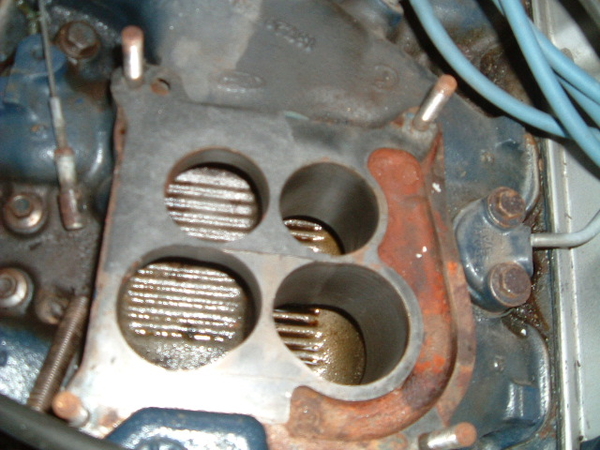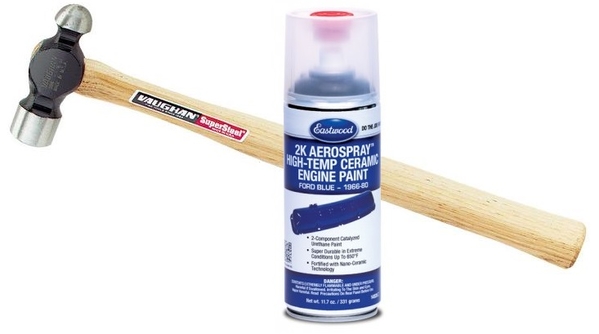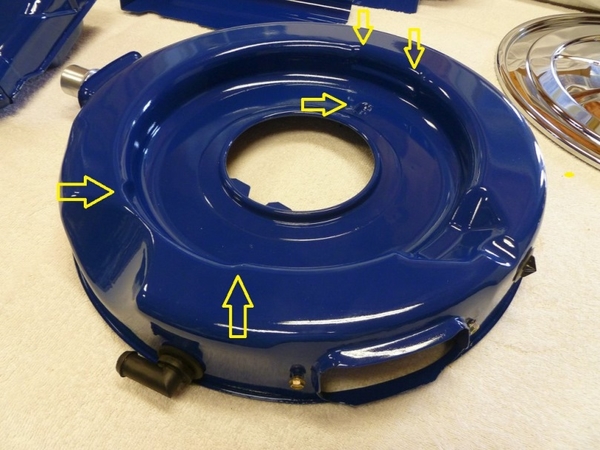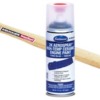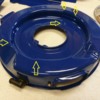Hi everyone!. What is the original manifold/carb combo (parts number) for a `72 Pantera?
Thanks
Replies sorted oldest to newest
But as you have been informed other options were available from the Factory.
There were two versions of the cast iron spread bore intake manifold designed for that carburetor, having casting numbers beginning D1ZE or D3ZE. The D3ZE manifold had a big trench running along side the carburetor mounting pad for exhaust gas recirculation. Your 1972 engine would have been equipped with the first version with a casting number beginning D1ZE (no trench).
Over in Europe I believe De Tomaso fitted the engines with 650 CFM Holley double pumper carburetors, Holley list number 4777. This was a much better carburetor. To install the Holley carburetor De Tomaso modified the spread bore intake manifold (elongated the large secondary butterfly holes) to allow the "square bore" Holley carburetor to fit.
The information about the Holleys in Europe is new to me. Have you got any references that I can show the inspectors when I take #2471 through the vehicle inspection? They are picky about these things. You guys don`t know how lucky you are.
The push button Panteras had aluminum Ford manifolds and 600 cfm Holley carburetors. The GTS Panteras had the list 4777 Holley carburetors. Your car apparently falls in between so I cannot say for sure if De Tomaso would have replaced the carburetor. Some of the other European owners need to chime-in and tell us what they've seen.
D2ZE is an engine part for 1972 mustangs. In Ford numbering the "D" stands for the decade of the 1970s, the "2" narrows it down to 1972.
If it were me I would install the Square bore cast iron manifold, casting number beginning D0AE and a Autolite 4300A "square bore" style carburetor. I can't believe a German inspector will know the difference between 1970/1971 factory parts and 1972 factory parts. The carburetors and manifolds all look the same. Once the car is inspected I'd remove the Autolite carburetor, place it on a shelf, and install a Holley carburetor to replace it.
Actually, I do realize how lucky I am. ![]()
The picture below shows the carburetor mounting pad of the D3ZE intake manifold, with the big exhaust gas trench on the right hand side.
Attachments
This is a picture of a D1ZE intake manifold (no trench, otherwise identical to the D3ZE version).
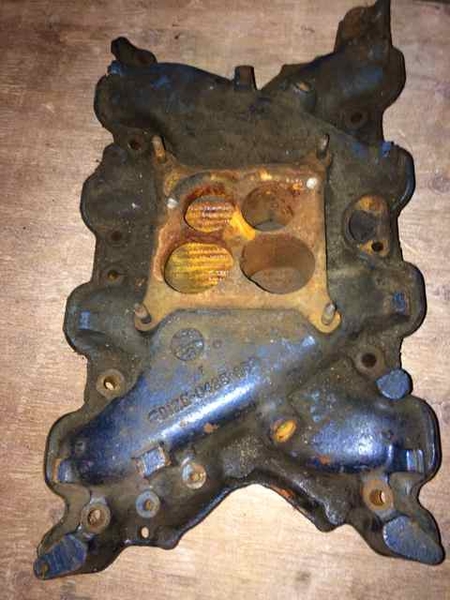
The manifolds in both pictures are from GTS Panteras. If you look closely at both pictures you'll see that the larger holes for the carburetor's secondary butterflies are not round, they are egg shaped. They have been elongated by De Tomaso to allow installation of a square bore Holley 4777 carburetor.
Attachments
quote:Originally posted by Bosswrench:
There is a Gr-3 Supplemental Parts Catalogue that lists a Holley carb and intake, ID-ed as 'Holley 213', DeTomaso part # 112 416, for Panteras. DeTomaso used his own part numbers on things sold in Europe, not necessarily Ford's part numbers. The Gr-3 History calls this a Holley 650 #4777, as George mentioned. Note that a DeTomaso 4-carb intake and four 48IDA Weber carbs were also listed as options. The GTS/GR-3 was a street legal upgrade version of the standard narrow body car sold in Europe as the GTS. Many Euro GTS had a few Gr-3 parts added by unknown sources, as they were widely available. Parts in the Supplement could be ordered direct from the factory, from local dealers who installed them at time of sale or picked up at the factory in Modena, IT later on and home-installed. Contact Anders Hellburg in Sweden for more information & details on GTS/Gr-3 (anders.hellburg@scuderiadetomaso.se)
Just picking up this thread again. I have a copy of the GTS supplementary parts catalogue and as Boss Wrench says here and other places, a Holley carburetor, referred to in the catalogue as part number 213 is mentioned. However, I haven't seen any documents saying that it is a Holley 4777 650cfm double pumper. It would be great if someone could point me in the right direction for this evidance, because I would like to be able to show it to any inspectors in the future (as demands for original or period corrrect modifications slowly tighten) that may question what was available from the factory in period.
Great info and pictures on the intake manifolds George - it sure was a quick and dirty way of installing a square bore carb!
Cheers, Tim.
The May 1974 issue of Road and Track magazine, page 48, quotes Peter Revson that the Holley carburetor installed in the GTS Pantera was part no. R4777AAA.
There are a few other references in other books and periodicals, but the information which confirmed to me which carburetor was installed has been based upon testimonial provided by owners, right here via these forums.
In the absence of a manufacturer that is in business, buyers, writers, businesses, and agencies are welcome to inquire with Pantera International for verification of various information. We provide such verification on a regular basis, mostly to assist owners in dealing with registration and inspection issues.
I am however disappointed that neither Isabella nor Santiago considered this international club for keeping the production information, instead it was trusted to the keeping of a private individual in Switzerland ... who charges owners more than a nominal fee for copies of documentation ... much more than what Kevin Marti charges.
greatly appreciate your info and the reference for the part number. I totally agree with you that it would be a great service to the community if the documentation about these cars was more readily available.
Cheers, Tim.
Hi, I am bringing this topic up again to ask what air cleaner was used from the factory with the Holley 4777 fitted to the Euro GTS and Gr3 Panteras? Was it the standard Ford Pantera aircleaner, or something else? I have what I think is the standard air cleaner, but it fouls on one end of the Holley where the nut is to adjust the floats - only on one end as the aircleaner is asymetrical, but I need an extra half inch or so extra between the holley and the bottom opening of the aircleaner to lift the air cleaner up sufficiently. I want a stock looking engine cleaner, not aftermarket.
Thanks for any help.
Cheers, Tim
Thanks :-) Lucky the air cleaner needs a strip and repaint anyway, so I can give it a bit of massaging first :-)
I have been struggling with the same manifold - carb question on 9193.
As is it has a Holley 600 CFM list 9834, model 4160 mated to a aluminum manifold that says "Performer" on it. I don't think this combo is period correct but I suspect that at that time (1980 GTS + - ) the Tomaso people were installing anything they had laying around. Records on this car are scares at best. The Swiss fellow wants $60.00 to tell me what the original engine was. All he has. Not sure I want to pay that for what I think I know. The engine has never been out of the car.
Do you guys think it's original and is spending the sixty worth it ? Think I'll have to sell the car due to California smog and registration laws so I would like to know what " original " is. Everything other than the carb and manifold appears to be stock and that's why I bought it. An original survivor that I want to keep that way.
Thoughts ? I don't mean to hijack this thread.
The De Tomaso organization did not operate hap hazard, installing anything they had laying around.
The Australian engines (351C) were equipped with Motorcraft 4300A carburetors during the XA and XB Falcon era. Those were square bore caburetors, and therefore a Holley four barrel carburetor was a simple substitution.
The engines built during the era of XC, XD, and XE Falcons were equipped with Carter Thermoquad carburetors, which were spread bore carburetors. The De Tomaso organization knew replacing the Carter carburetor with a Holley carburetor was worth about 100 horsepower. So I'm sure they replaced them. BUT I don't think the Carter Thermoquad bolt pattern was compatible with Holley carburetors. It wouldn't surprise me if the Australian cast iron spread bore intake manifold was replaced by an Edelbrock model 2750 performer 2V intake manifold, plus the usual Holley 4777 carburetor. But we've never really broached this subject before here on the forums.
So at this point we need input from owners of Panteras built from about 1977 and later … would they please share with us what carburetors and manifolds were their Panteras (GTS, Grp 3, GT5, and GT5-S) originally equipped with.
Keep in mind that cars brought into the US during the grey market era had to be DOT'd and EPA'd. Whatever carburetor they had in Europe would most likely have been replaced with something calibrated leaner here in the US. Kirk Evans is the hands down expert in this area.


